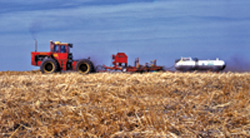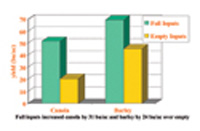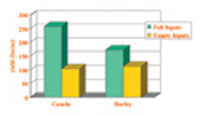
Precision Ag
Impact of inputs on profitability of canola and barley
Be careful when shaving inputs.
November 29, 2007 By Donna Fleury
Researchers are reaching the end of the second year of a four year intensive
study comparing the relative importance of inputs for canola and barley crops.
So far, only results for the 2005 growing year are available, but there are
some preliminary observations that can be shared. Full results will not be available
until after the 2008 crop year.
 |
| Cutting fertilizer rates hurt high yield canola. Photos Courtesy Of Bruce Barker. |
Researchers began comparing canola and barley production in 2005, using various
input combinations, at Scott and Melfort, Saskatchewan and at Lacombe, Beaverlodge,
Lethbridge and Fort Vermilion, Alberta. Led by Stew Brandt, crop management
agronomist at the Scott Research Farm, the study is based on evaluating responses
to individual inputs as they are either removed from a 'full' package of inputs
or added to an 'empty' package of inputs.
The canola full package includes InVigor 5020, seeding rate of 150 seeds per
square metre, full fertilizer and full herbicide inputs. The canola empty package
is an open-pollinated canola (LBD2393LL), seeding rate of 75 seeds per square
metre, no fertilizer or herbicide inputs. The full barley package is AC Metcalfe,
seeding rate of 300 seeds per square metre, full fertilizer and herbicide. The
empty barley package is Harrington, seeding rate of 150 seeds per square metre,
no fertilizer or herbicide inputs. In the first year of the experiments, weeds
were sown to ensure uniform weed populations.
Additional treatments to the full package compared reducing fertilizer and
herbicides to half rate and zero rate. The empty package treatments compared
adding fertilizer and herbicides at half rate and full rate. Researchers expect
that the responses will be different when inputs are removed from a full package,
as compared to adding inputs back to an empty package. The same input strategy
is applied to each plot for the four year period to evaluate cumulative effects
of inputs.
| Figure 1. Influence of full versus empty inputs on yield (bu/ac). Full inputs increased canola by 31bu/ac and barley by 24bu/ac over empty. |
 |
"We can make some very preliminary observations based on the 2005 data,
and from in-field observations of the 2006 trials," says Brandt. "We
see that responses are highly variable from location to location, and likely
from year to year at any one location." For example, at the Melfort site
in 2006, the weed responses appeared to be different than what was experienced
in 2005. "The full package canola without any herbicides actually looked
quite good, but the empty package without any herbicides had a lot of weed competition,"
says Brandt. "However, until we see the data, we won't know for sure what
the true impacts are."
The research results from 2005 show that the yields of canola going from an
empty package to a full package of inputs increased by 31bu/ac, increasing from
20.9bu/ac to 51.8bu/ac. In comparison, barley yields only increased 24bu/ac,
increasing from 45.6bu/ac to 69.6bu/ac, going from an empty package to a full
package.
Translating that into dollar figures with canola at $5 per bushel, the gross
returns are $104.50 per acre for the empty package and $259 per acre for the
full package. In comparison with barley at $2.50 per bushel, the gross returns
are $114 for the empty package and $174 per acre for the full package.
| Figure 2. Influence of full versus empty inputs on total returns ($/ac) with canola at $5/bu and barley at $2.50/bu. |
 |
"These preliminary results shouldn't come as any surprise, as we've known
for a long time that canola is a crop that responds very to well to inputs,"
says Brandt. "It appears that cutting inputs that protect yield may be
a better target than those that build yield potential." Inputs that build
or establish yield potential include crop variety, soil fertility, fertilizers
and seeding rate. Inputs or practices that protect yield potential include seed
treatment, herbicides and fungicides.
The first year of results suggests there may be an opportunity to reduce herbicide
inputs, particularly if growing varieties that are highly competitive. "With
empty inputs, 200 percent herbicide rates increased canola yield by 50 percent,
but only by 14 percent with full inputs, and even the 50 percent rate provided
adequate control," explains Brandt. "The economic impact with herbicides
was also much greater with the empty input package, increasing crop value by
$52 per acre compared with an increase of only $30 with full inputs."
However, in all cases, the increased value more than offset the added herbicide
costs of about $13 and $26 at the low and high rates. On the other hand, the
yield responses of barley to herbicides were more modest. The response from
the full herbicide rate typically fell short of covering the $24 per acre cost
for the full rate, however, the half rate typically provided an economic response
for barley.
Averaged across all locations, the yield advantage of the improved canola cultivar
was 18 percent or 7.6bu/ac with 'full' inputs. With 'empty' inputs the yield
advantage was 27 percent or 5.6bu/ac. The percentage yield increase suggests
that the improved cultivar was better suited to low inputs. However, the value
of the increased yield was greatest with 'full' inputs because the yield response
as bushels per acre was much higher. Thus the economic value of the improved
canola cultivar was greatest with full inputs.
With barley, the effect of cultivar was quite small with full or empty inputs.
"Percentage yield increases tell us something about the science underlying
input responses," says Brandt. "Economic analysis is needed to understand
the economic implications of input use, and the science and economics don't
always tell the same story.
"We will need a lot more information to predict responses and to make
more efficient use of inputs," says Brandt. "Cutting inputs when they
are needed can have a drastic impact on yields and economic returns. We also
don't know the cumulative impacts of cutting inputs over the long-term."
The final results from this four year study, which will be available after the
2008 crop year, will help understand the agronomics much better. "The bottom
line is growers should approach input cuts very cautiously, particularly if
they are inputs that are really needed."